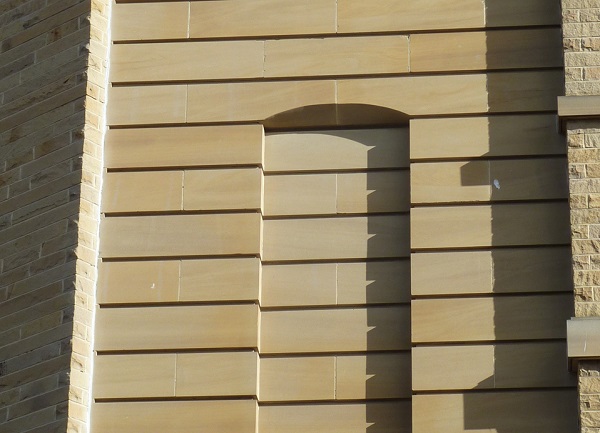Ashlar
Ashlar is a type of masonry which is finely cut and/or worked, and is characterised by its smooth, even faces and square edges. It can also be used to refer to an individual stone that has been finely cut and worked until squared.
Ashlar has been used in construction as an alternative to brick or other materials dating back to classical architecture, where it was often used to contrast with rustication (masonry with a purposefully rough or patterned surface).
Courses of ashlar can be horizontal, with blocks laid in parallel, or may be random with deliberately discontinuous vertical and horizontal joints.
Since ashlar blocks are precisely cut on all faces which are adjacent to other masonry, very thin joints can be achieved. The face of the block away from joints may be left rough and unpolished (known as quarry-faced), or may be polished or rendered decoratively. Mason’s drag is a form of decoration used on softer stone ashlar which involves small grooves applied by a metal comb-like device.
Mortar, or another joining material, is used to bind ashlar blocks together. Other methods of assembly such as metal ties can be used, in a process known as dry ashlar. Such a technique can be seen in the Inca architecture of Cusco and Machu Picchu.
In the UK, ashlar walling can be found in many historic buildings; one notable example being the Royal Crescent in Bath. It is also becoming more popular as a form of exterior cladding in urban commercial developments.
Society for the Protection of Ancient Buildings (SPAB) definition from their online Glossary : 'Finely dressed stone laid in regular courses with thin joints.'
[edit] Related articles on Designing Buildings
Featured articles and news
A threat to the creativity that makes London special.
How can digital twins boost profitability within construction?
The smart construction dashboard, as-built data and site changes forming an accurate digital twin.
Unlocking surplus public defence land and more to speed up the delivery of housing.
The Planning and Infrastructure bill oulined
With reactions from IHBC and others on its potential impacts.
Farnborough College Unveils its Half-house for Sustainable Construction Training.
Spring Statement 2025 with reactions from industry
Confirming previously announced funding, and welfare changes amid adjusted growth forecast.
Scottish Government responds to Grenfell report
As fund for unsafe cladding assessments is launched.
CLC and BSR process map for HRB approvals
One of the initial outputs of their weekly BSR meetings.
Architects Academy at an insulation manufacturing facility
Programme of technical engagement for aspiring designers.
Building Safety Levy technical consultation response
Details of the planned levy now due in 2026.
Great British Energy install solar on school and NHS sites
200 schools and 200 NHS sites to get solar systems, as first project of the newly formed government initiative.
600 million for 60,000 more skilled construction workers
Announced by Treasury ahead of the Spring Statement.
The restoration of the novelist’s birthplace in Eastwood.
Life Critical Fire Safety External Wall System LCFS EWS
Breaking down what is meant by this now often used term.
PAC report on the Remediation of Dangerous Cladding
Recommendations on workforce, transparency, support, insurance, funding, fraud and mismanagement.
New towns, expanded settlements and housing delivery
Modular inquiry asks if new towns and expanded settlements are an effective means of delivering housing.























